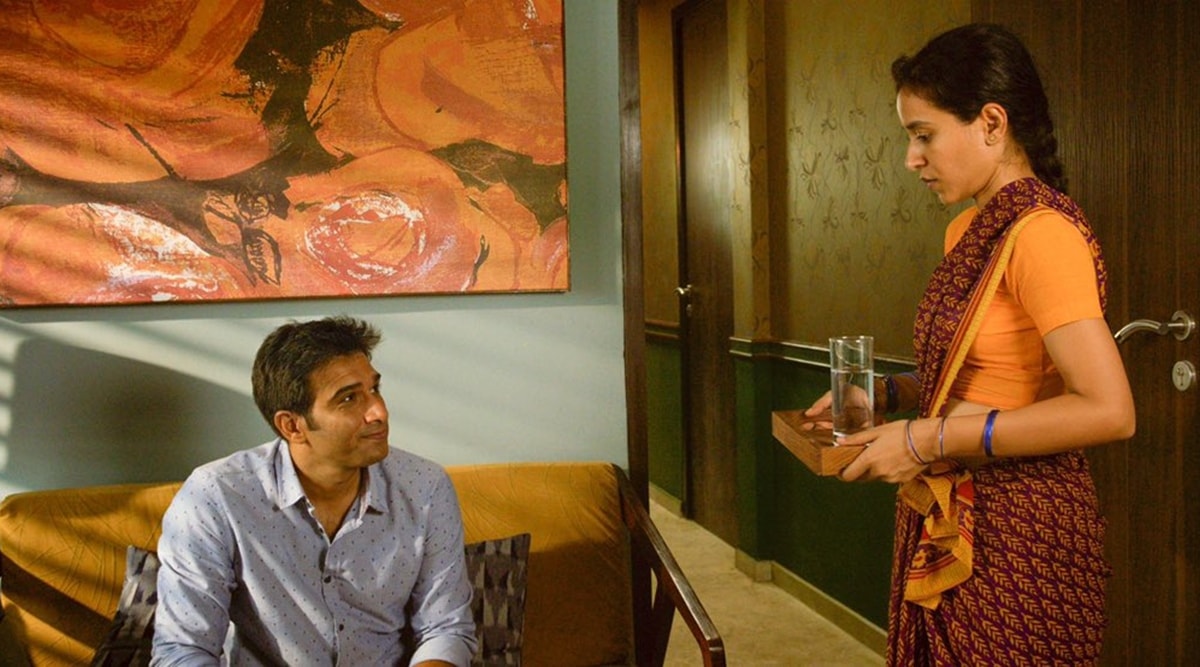Sir is an unusual, courageous traverse into unfamiliar, difficult territory, stepping in very carefully into the minefield which people like us have taken for granted for years.
Sir movie cast: Tillotama Shome, Vivek Gomber, Geetanjali Kulkarni, Rahul Vohra, Anupriya Goenka, Chandrachur Rai
Sir movie director: Rohena Gera
Sir movie rating: Three stars
Even in a plush high-rise in Mumbai, a megacity presumably without as many raised moralistic eyebrows as other places in India, the sharing of space in the same flat between a single man and a ‘maid’, can set tongues wagging.
In Rohena Gera’s Sir, it does come up, only to swept aside swiftly and decisively by Ratna (Shome): she is here only to make a better life for herself, and for her family left behind in the village. With her salary, she’s helping her sister get an education, and the residue will someday help her fulfil her own dreams. It’s only when her employer, the recently single Ashwin (Gomber) starts to see her as a personable person, rather than just a convenient fixture, that the divide between class starts to blur.
Is the blurring enough, though, for two people from such diverse backgrounds to come together romantically? How will an unsophisticated Marathi-speaking village girl, however dignified she may be, and Shome does a brilliant job of coming across as a young woman of immense dignity and self-respect, bridge that near-insurmountable divide that comes with wealth and privilege? How will it work with a man who uses English with his family and friends as the language of communication, dropping into stilted vernacular when instructing domestics, like so many of us urban types?
Sir is an unusual, courageous traverse into unfamiliar, difficult territory, stepping in very carefully into the minefield which people like us have taken for granted for years. It’s only because Ashwin has lived a spell in the US that he is able to talk to Ratna with a degree of respect, unlike his pretty party pal (Goenka), who deals out a stinging, humiliating slap to the ‘servant’. For a film which is subtle in many of its notes, the bald use of the word ‘servant’, from Ratna’s mouth, serves as a double-edged sword: in the saying of it, she is acknowledging her own awareness of the chasm between them, as well our discomfiture at this unlikely couple.
We start by seeing the two inhabit different spaces in the flat, she in her small ‘SQ’ (servant’s quarter) and the kitchen, he in the rest of the house. Slowly, as they begin drawing closer, they start sharing the same frame, tumbling rather too suddenly into intimacy. Some more time spent between the two, some more negotiating bends, and the relationship could have been built upon a bit more: I missed those in-between moments which take place between scrupulously observed distance, and the awareness between a man and a woman.
Finally, a film like this, with its fairy-tale arc, depends on how much it can make us believe in the fact of an Ashwin and a Ratna finding lasting commonalities. The ugly real-life fact in India of all-powerful employers preying sexually upon domestics, and how these things can quickly become unsavoury jokes, is side-stepped by the fact of Ashwin being the kind of guy he is. You can see he is kind and compassionate, both qualities Gomber radiates well, and that his loneliness is being assuaged by this intelligent young woman. You can see the distance being bridged by both beginning to share little details of their day, slowly, awkwardly, but surely. And the fact that the film manages to do this, and create believable upstairs-downstairs characters without being patronizing, is nice: Geetanjali Kulkarni, as the ‘maid’ working in a neighbouring flat, and the only one Ratna can depend upon, is terrific.
Will Ashwin and Ratna live happily ever after? Sir, out in theatres today, scores in being able to even pose such a question, with pleasing delicacy. As to the question, who knows what the morrow will bring, but we are all allowed to dream, aren’t we?
Source: Read Full Article




